The Impact of Optimized Daylight and Views on the Sleep Duration and Cognitive Performance of Office Workers
Abstract
1. Introduction
2. Materials and Methods
2.1. Study Design
2.2. Study Population
2.3. Environmental Conditions
2.4. Daily Surveys
2.5. Sleep Assessment
2.6. Cognitive Assessment
2.7. Statistical Analysis
3. Results
3.1. Sleep Assessment
3.2. Cognitive Function
4. Discussion
- Task management: the ability to respond to plans and organizational initiatives with optimal goal setting, goal development, and goal fulfillment.
- Information management: the ability to search for optimal information in an efficacious manner and use it appropriately based on situational demands.
- Strategy management: the ability to conceptualize multiple approaches and form systematic plans and actions that are optimally sequenced and integrated toward goal fulfillment.
- Crisis management: the ability to build contingency plans that will enable the organization to cope effectively under exigent conditions.
5. Conclusions
Author Contributions
Funding
Conflicts of Interest
References
- Haynes, B.P. The impact of office comfort on productivity. J. Facil. Manag. 2008, 6, 37–51. [Google Scholar] [CrossRef]
- Heschong Mahosne Group. Windows and offices: A study of office worker performance and the indoor environment. Calif. Energy Commision 2003, 37, 414–435. [Google Scholar]
- Thayer, B.M. Daylighting and Productivity at Lockheed. 1995. Available online: https://www.osti.gov/servlets/purl/258772 (accessed on 20 March 2020).
- Roenneberg, T.; Kantermann, T.; Juda, M.; Vetter, C.; Allebrandt, K.V. Light and the human circadian clock. Handb. Exp. Pharmacol. 2013, 311–331. [Google Scholar] [CrossRef]
- Klepeis, N.E.; Nelson, W.C.; Ott, W.R.; Robinson, J.P.; Tsang, A.M.; Switzer, P.; Behar, J.V.; Hern, S.C.; Engelmann, W.H. The National Human Activity Pattern Survey (NHAPS): A resource for assessing exposure to environmental pollutants. J. Expo. Anal. Environ. Epidemiol. 2001, 11, 231–252. [Google Scholar] [CrossRef]
- Bower, B.; Bylsma, L.M.; Morris, B.H.; Rottenberg, J. Poor reported sleep quality predicts low positive affect in daily life among healthy and mood-disordered persons. J. Sleep Res. 2010, 19, 323–332. [Google Scholar] [CrossRef]
- Leppamaki, S.; Partonen, T.; Vakkuri, O.; Lonnqvist, J.; Partinen, M.; Laudon, M. Effect of controlled-release melatonin on sleep quality, mood, and quality of life in subjects with seasonal or weather-associated changes in mood and behaviour. Eur. Neuropsychopharmacol. 2003, 13, 137–145. [Google Scholar] [CrossRef]
- Nebes, R.D.; Buysse, D.J.; Halligan, E.M.; Houck, P.R.; Monk, T.H. Self-reported sleep quality predicts poor cognitive performance in healthy older adults. J. Gerontol Ser. B Psychol. Sci. Soc. Sci. 2009, 64, 180–187. [Google Scholar] [CrossRef]
- Knutson, K.L.; Ryden, A.M.; Mander, B.A.; Van Cauter, E. Role of sleep duration and quality in the risk and severity of type 2 diabetes mellitus. Arch. Intern. Med. 2006, 166, 1768–1774. [Google Scholar] [CrossRef]
- Kim, Y.; Wilkens, L.R.; Schembre, S.M.; Henderson, B.E.; Kolonel, L.N.; Goodman, M.T. Insufficient and excessive amounts of sleep increase the risk of premature death from cardiovascular and other diseases: The Multiethnic Cohort Study. Prev. Med. (Baltim) 2013, 57, 377–385. [Google Scholar] [CrossRef]
- Kochanek, K.D.; Murphy, S.L.; Xu, J.; Arias, E. Mortality in the United States, 2013. NCHS Data Brief. 2014, 178, 1–8. [Google Scholar]
- Sheehan, C.M.; Frochen, S.E.; Walsemann, K.M.; Ailshire, J.A. Are U.S. adults reporting less sleep? Findings from sleep duration trends in the National Health Interview Survey, 2004–2017. Sleep 2019, 42. [Google Scholar] [CrossRef]
- Boubekri, M.; Cheung, I.N.; Reid, K.J.; Wang, C.H.; Zee, P.C. Impact of windows and daylight exposure on overall health and sleep quality of office workers. J. Clin. Sleep Med. 2014, 10, 603–611. [Google Scholar] [CrossRef]
- Bub, K.; Curry, K.; Boubekri, M.; Lee, J. Let there be (day)light: Investigating the links between classroom daylighting, sleep and learning-related skills. In Proceedings of the American Educational Research Association Conference, San Francisco, CA, USA, 17–21 April 2020. [Google Scholar]
- Akerstedt, T. Consensus Statement: Fatigue and accidents in transport operations. J. Sleep Res. 2000, 9, 395. [Google Scholar]
- Leger, D. The cost of sleep-related accidents: A report for the national commission on sleep disorders research. Sleep 1994, 17, 84–93. [Google Scholar] [CrossRef]
- Mitler, M.M.; Carskadon, M.A.; Czeisler, C.A.; Dement, W.C.; Dinges, D.F.; Graeber, R.C. Catastrophes, sleep, and public policy: Consensus report. Sleep 1988, 11, 100–109. [Google Scholar] [CrossRef]
- Ling, A.; Lim, M.L.; Gwee, X.; Ho, R.C.; Collinson, S.L.; Ng, T.P. Insomnia and daytime neuropsychological test performance in older adults. Sleep Med. 2016, 17, 7–12. [Google Scholar] [CrossRef]
- Ulrich, R.S. View through a window may influence recovery from surgery. Science 1984, 224, 420–421. [Google Scholar] [CrossRef]
- Yin, J.; Zhu, S.; MacNaughton, P.; Allen, J.G.; Spengler, J.D. Physiological and cognitive performance of exposure to biophilic indoor environment. Build. Environ. 2018, 132, 255–262. [Google Scholar] [CrossRef]
- Yin, J.; Arfaei, N.; MacNaughton, P.; Catalano, P.J.; Allen, J.G.; Spengler, J.D. Effects of biophilic interventions in office on stress reaction and cognitive function: A randomized crossover study in virtual reality. Indoor Air 2019, 29, 1028–1039. [Google Scholar] [CrossRef]
- Kellert, S.R.; Wilson, E.O. The Biophilia Hypothesis; Island Press: Washington, DC, USA, 1993. [Google Scholar]
- Heerwagen, J.H.; Orians, G.H. Adaptations to Windowlessness: A study of the use of visual decor in windowed and windowless offices. Environ. Behav. 1986, 18, 623–639. [Google Scholar] [CrossRef]
- Browning, W.; Ryan, C.; Clancy, J. 14 Patterns of biophilic design: Improving health & well-being in the built environment. Terrapin Bright Green LLC 2014, 1–60. [Google Scholar] [CrossRef]
- Nezamdoost, A.; Van Den Wymelenberg, K. Blindswitch 2017: Proposing a new manual blind control algorithm for daylight and energy simulation. In Proceedings of the Illuminating Engineering Society Annual Conference, Portland, OR, USA, 10–12 August 2017. [Google Scholar]
- Spitschan, M.; Stefani, O.; Blattner, P.; Gronfier, C.; Lockley, S.W.; Lucas, R.J. How to report light exposure in human chronobiology and sleep research experiments. Clocks Sleep 2019, 1, 280–289. [Google Scholar] [CrossRef]
- Von Erberich, P.; Graeber, K. Circadian Lighting Design: Leveraging the Melanopic Efficacy of Luminous Radiation Metric. Available online: https://cltc.ucdavis.edu/publication/lda-research-matters-circadian-lighting-design-leveraging-melanopic-efficacy-luminous (accessed on 20 March 2020).
- Lucas, R.J.; Peirson, S.N.; Berson, D.M.; Brown, T.M.; Cooper, H.M.; Czeisler, C.A.; Figueiro, M.G.; Gamlin, P.D.; Lockley, S.W.; O’Hagan, J.B.; et al. Measuring andu sing light in the melanopsin age. Trend. Neurosci. 2014, 37, 1–9. [Google Scholar] [CrossRef]
- Rae, M.; Figeuiro, M.G. Light as a circadian stimulus for architectural lighting. Light. Res. Tech. 2018, 50, 497–510. [Google Scholar]
- Figueiro, M.G.; Gonzales, K.; Pedler, D.R. Designing with circadian stimulus. Light. Des. Appl. 2016, 8, 30–34. [Google Scholar]
- Cole, R.J.; Kripke, D.F.; Mullaney, D.J.; Gillin, J.C. Automatic sleep/wake identification from wrist activity. Sleep 1992, 15, 461–469. [Google Scholar] [CrossRef]
- Satish, U.; Streufert, S.; Dewan, M.; Voort, S. Vande. Improvements in simulated real-world relevant performance for patients with seasonal allergic rhinitis: Impact of desloratadine. Allergy 2004, 59, 415–420. [Google Scholar] [CrossRef]
- Streufert, S.; Pogash, R.; Piasecki, M. Simulation-based assessment of managerial competence: Reliability and validity. Pers. Psychol. 1988, 41, 537–557. [Google Scholar] [CrossRef]
- Streufert, S.; Swezey, R.W. Complexity, Managers, and Organizations; Swezey, R.W., Ed.; Academic Press: Orlando, FL, USA, 1986. [Google Scholar]
- Quante, M.; Kaplan, E.R.; Cailler, M.; Rueschman, M.; Wang, R.; Weng, J.; Taveras, E.M.; Redline, S. Actigraphy-based sleep estimation in adolescents and adults: A comparison with polysomnography using two scoring algorithms. Nat. Sci. Sleep. 2018, 10, 13–20. [Google Scholar] [CrossRef]
- Fuhr, L.; Abreu, M.; Pett, P.; Relógio, A. Circadian systems biology: When time matters. Comput. Struct. Biotechnol. J. 2015, 13, 417–426. [Google Scholar] [CrossRef]
- Bhadra, U.; Thakkar, N.; Das, P.; Pal Bhadra, M. Evolution of circadian rhythms: From bacteria to human. Sleep Med. 2017, 35, 49–61. [Google Scholar] [CrossRef]
- Razavi, P.; Devore, E.E.; Bajaj, A.; Figueiro, M.G.; Ricchiuti, V.; Gauderman, W.J.; Hankinson, S.E.; Willett, W.C.; Schernhammer, E.S. Shift work, chronotype, and melatonin rhythm in nurses. Cancer Epidemiol. Biomark. Prev. 2019, 28, 1177–1186. [Google Scholar] [CrossRef] [PubMed]
- Chapotot, F.; Gronfier, C.; Jouny, C.; Muzet, A.; Brandenberger, G. Cortisol secretion is related to electroencephalographic alertness in human subjects during daytime wakefulness. J. Clin. Endocrinol. Metab. 1998, 83, 4263–4268. [Google Scholar] [CrossRef] [PubMed]
- Heschong, L.; Saxena, M.; Wright, R.; Okura, S.; Aumann, D. Offices, windows and daylight: Call center worker performance. Heschong Mahone Group Calif. Energy Comm. 2004, 7, 98–110. [Google Scholar]
- Satish, U.; Mendell, M.J.; Shekhar, K.; Hotchi, T.; Sullivan, D.; Streufert, S.; Fisk, W.J. Is CO2 an indoor pollutant? Direct effects of low-to-moderate CO2 concentrations on human decision-making performance. Environ. Health Perspect 2012, 120, 1671–1677. [Google Scholar] [CrossRef]
- Allen, J.G.; MacNaughton, P.; Satish, U.; Santanam, S.; Vallarino, J.; Spengler, J.D. Associations of cognitive function scores with carbon dioxide, ventilation, and volatile organic compound exposures in office workers: A controlled exposure study of green and conventional office environments. Environ. Health Perspect 2016, 124, 805–812. [Google Scholar] [CrossRef]
- Allen, J.G.; MacNaughton, P.; Laurent, J.G.C.; Flanigan, S.S.; Eitland, E.S.; Spengler, J.D. Green buildings and health. Curr. Environ. Heal. Rep. 2015, 2, 250–258. [Google Scholar] [CrossRef]
- Zhang, M.W.; Tran, B.X.; Huong, L.T.; Hinh, N.D.; Nguyen, H.L.; Tho, T.D.; Latkin, C.; Ho, R.C. Internet addiction and sleep quality among Vietnamese youths. Asian J. Psychiatr. 2017, 28, 15–20. [Google Scholar] [CrossRef]
- Le, T.A.; Dang, A.D.; Tran, A.H.; Nguyen, L.H.; Nguyen, T.H.; Phan, H.T.; Latkin, C.A.; Tran, B.X.; Ho, C.S.; Ho, R.C. Factors associated with sleep disorders among methadone-maintained drug users in Vietnam. Int. J. Environ. Res. Public Health 2019, 16, 4315. [Google Scholar] [CrossRef]
- Cedeño Laurent, J.G.; Williams, A.; Oulhote, Y.; Zanobetti, A.; Allen, J.G.; Spengler, J.D. Reduced cognitive function during a heat wave among residents of non-air-conditioned buildings: An observational study of young adults in the summer of 2016. PLoS Med. 2018, 15. [Google Scholar] [CrossRef]
- Yeganeh, A.J.; Reichard, G.; McCoy, A.P.; Bulbul, T.; Jazizadeh, F. Correlation of ambient air temperature and cognitive performance: A systematic review and meta-analysis. Build. Environ. 2018, 143, 701–716. [Google Scholar] [CrossRef]
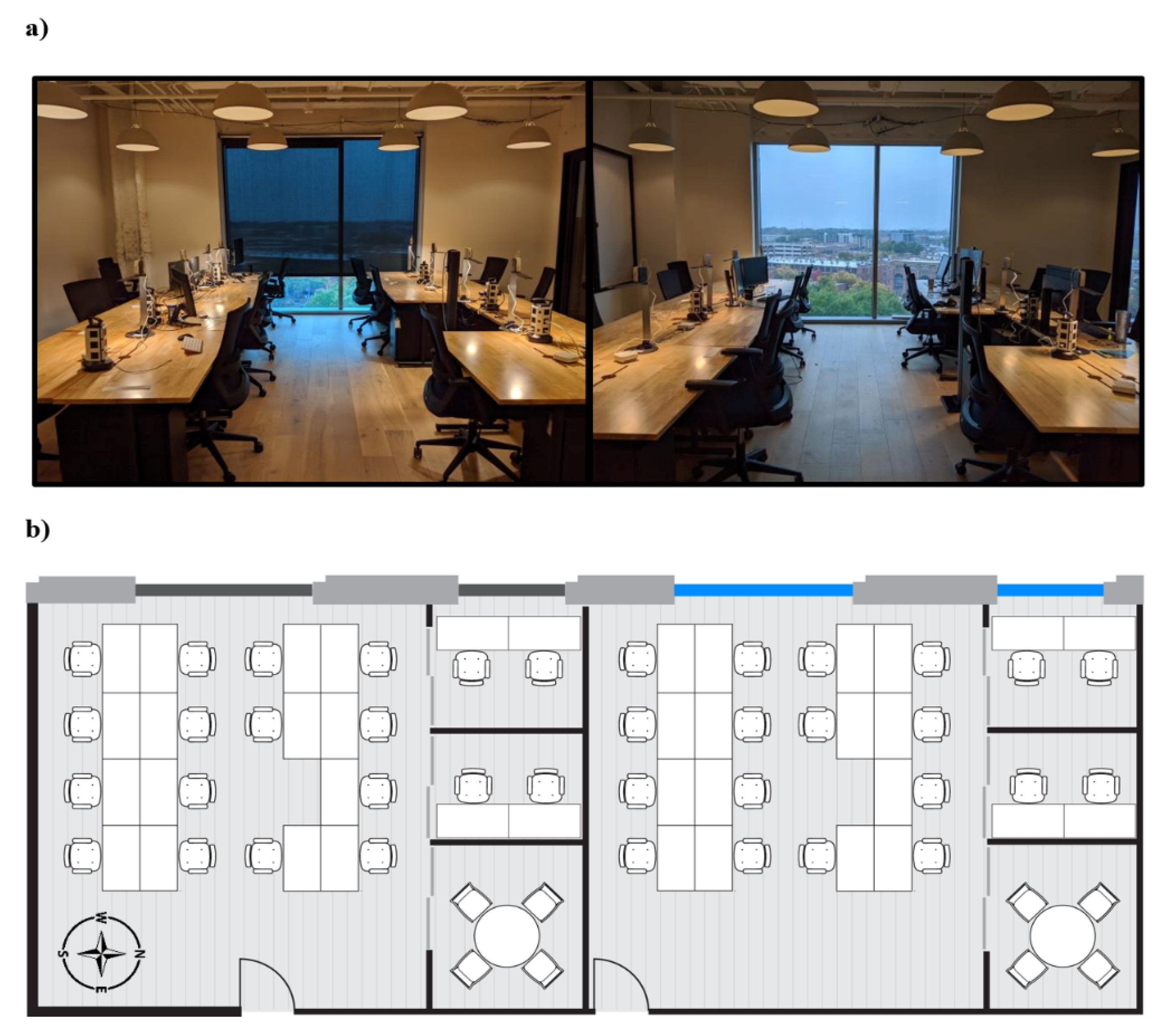
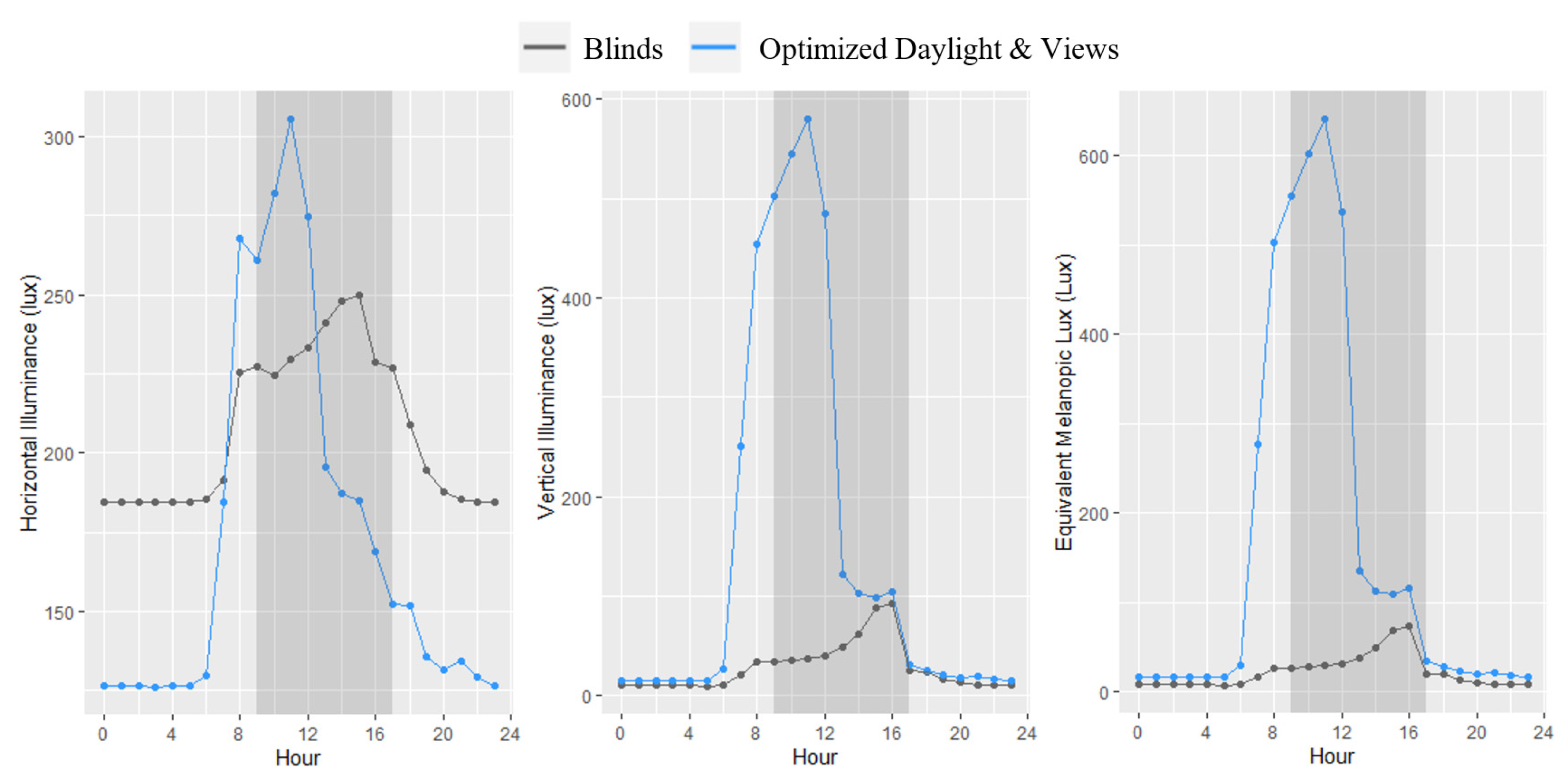
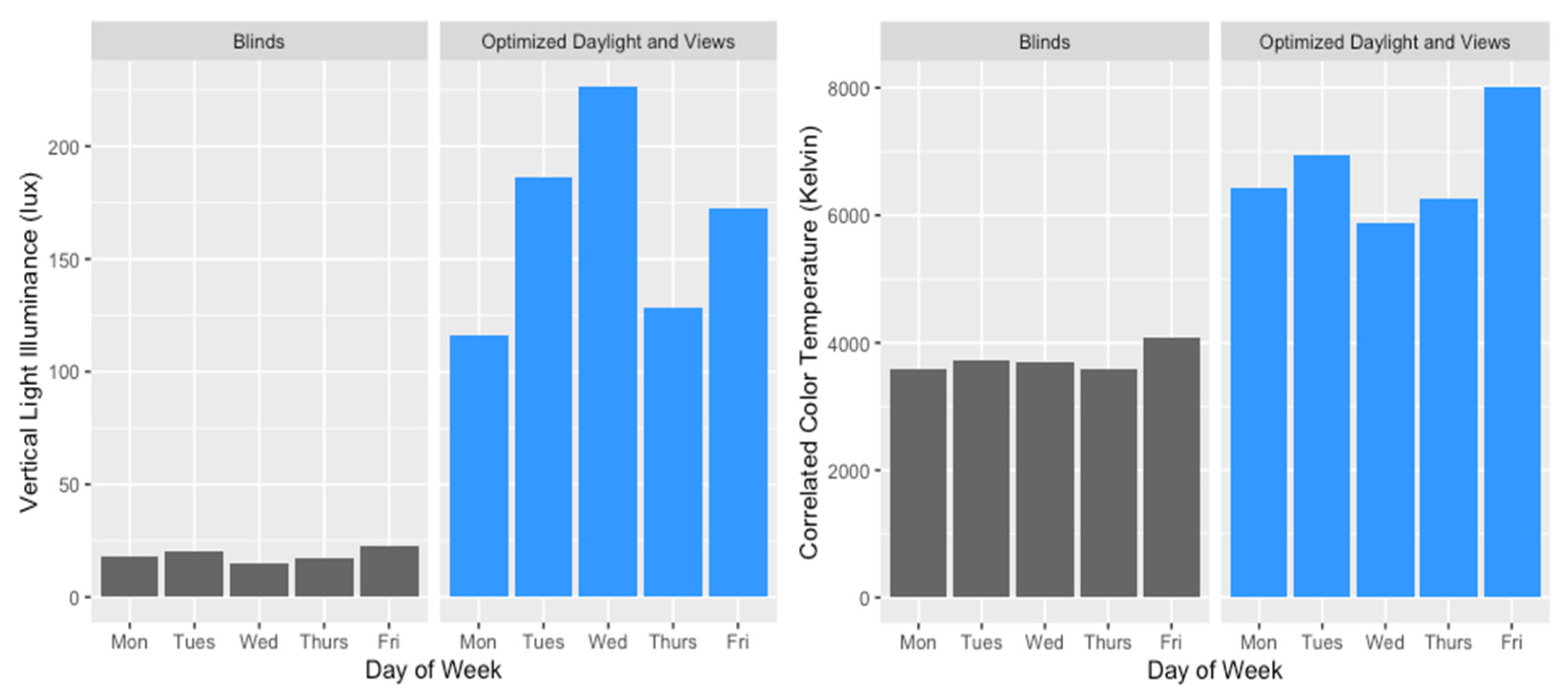
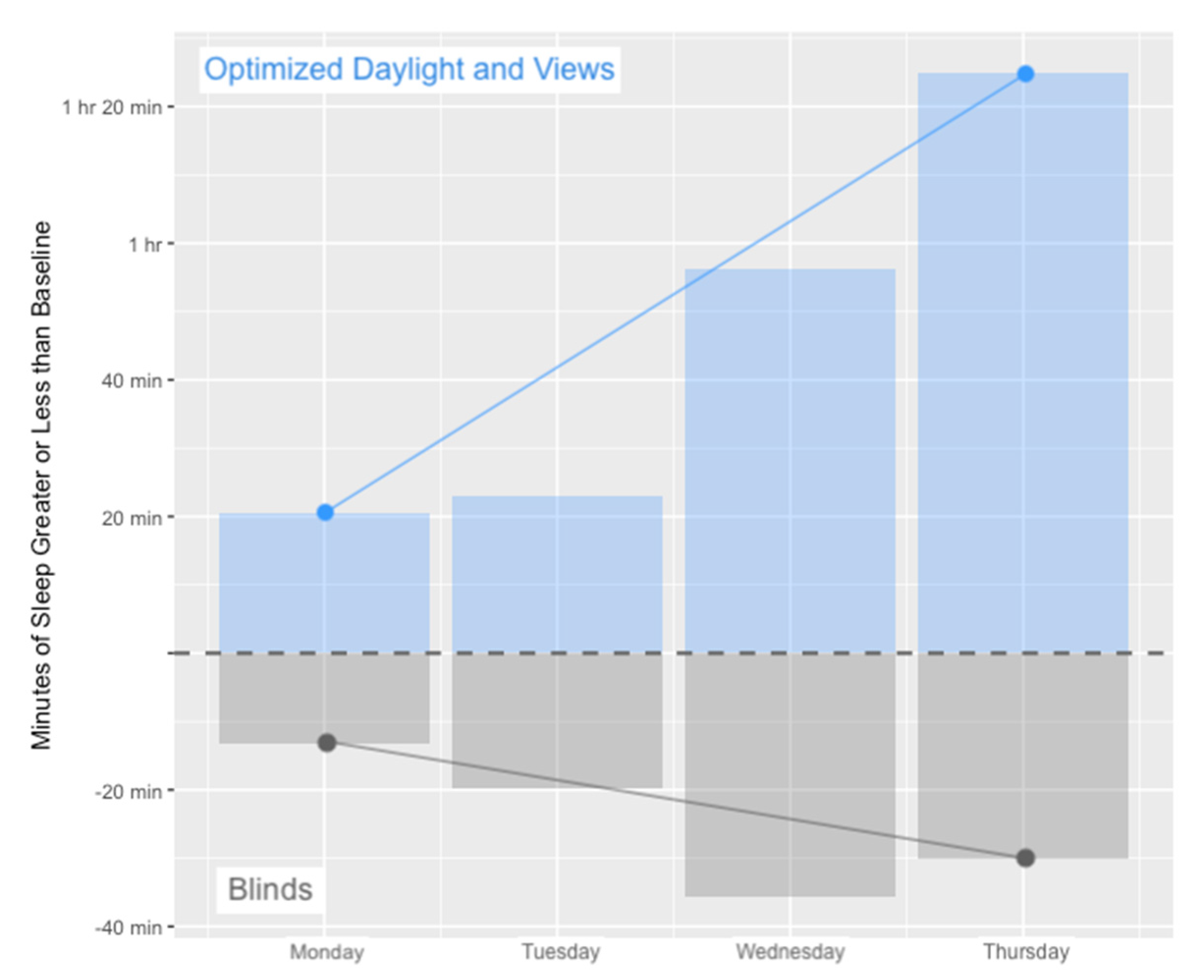
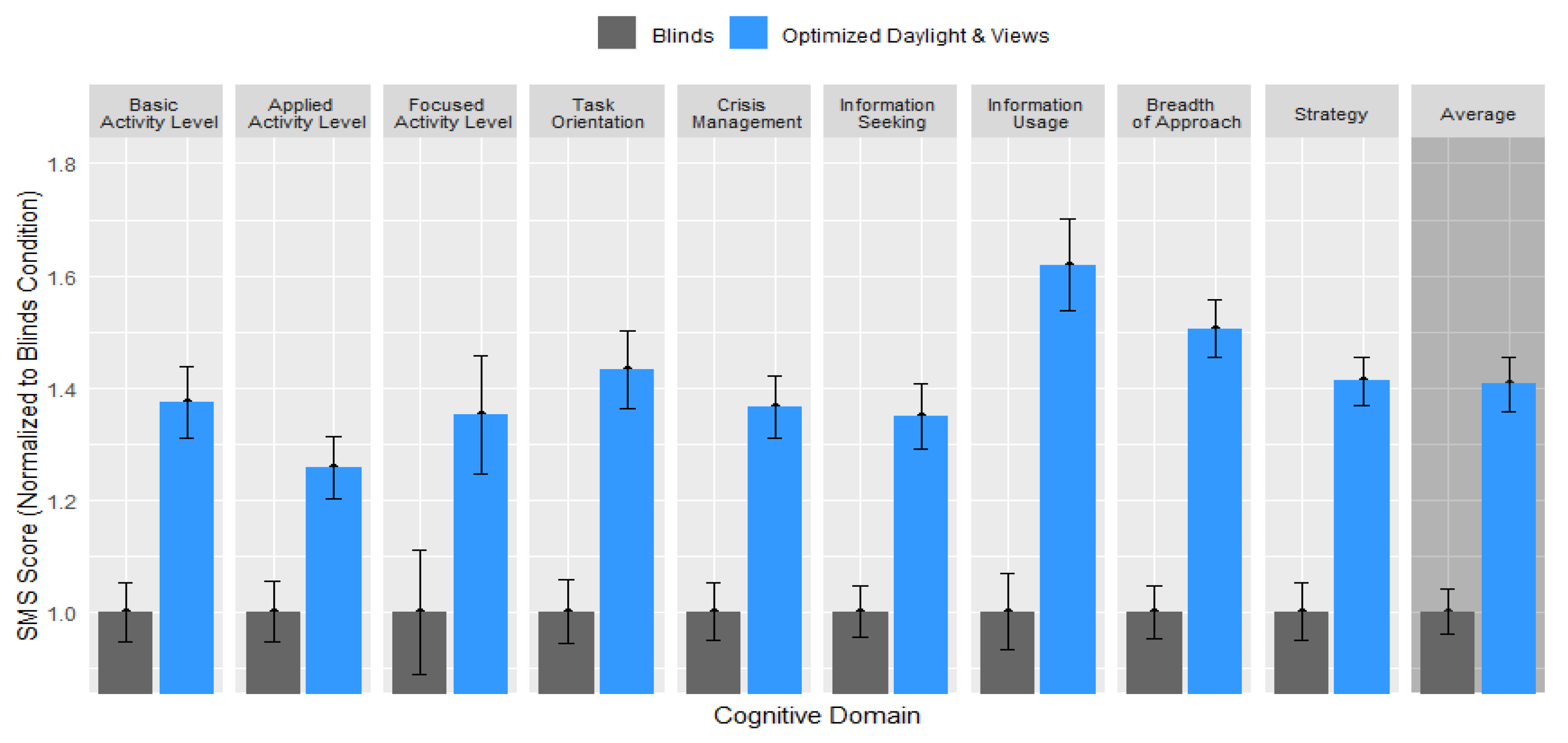
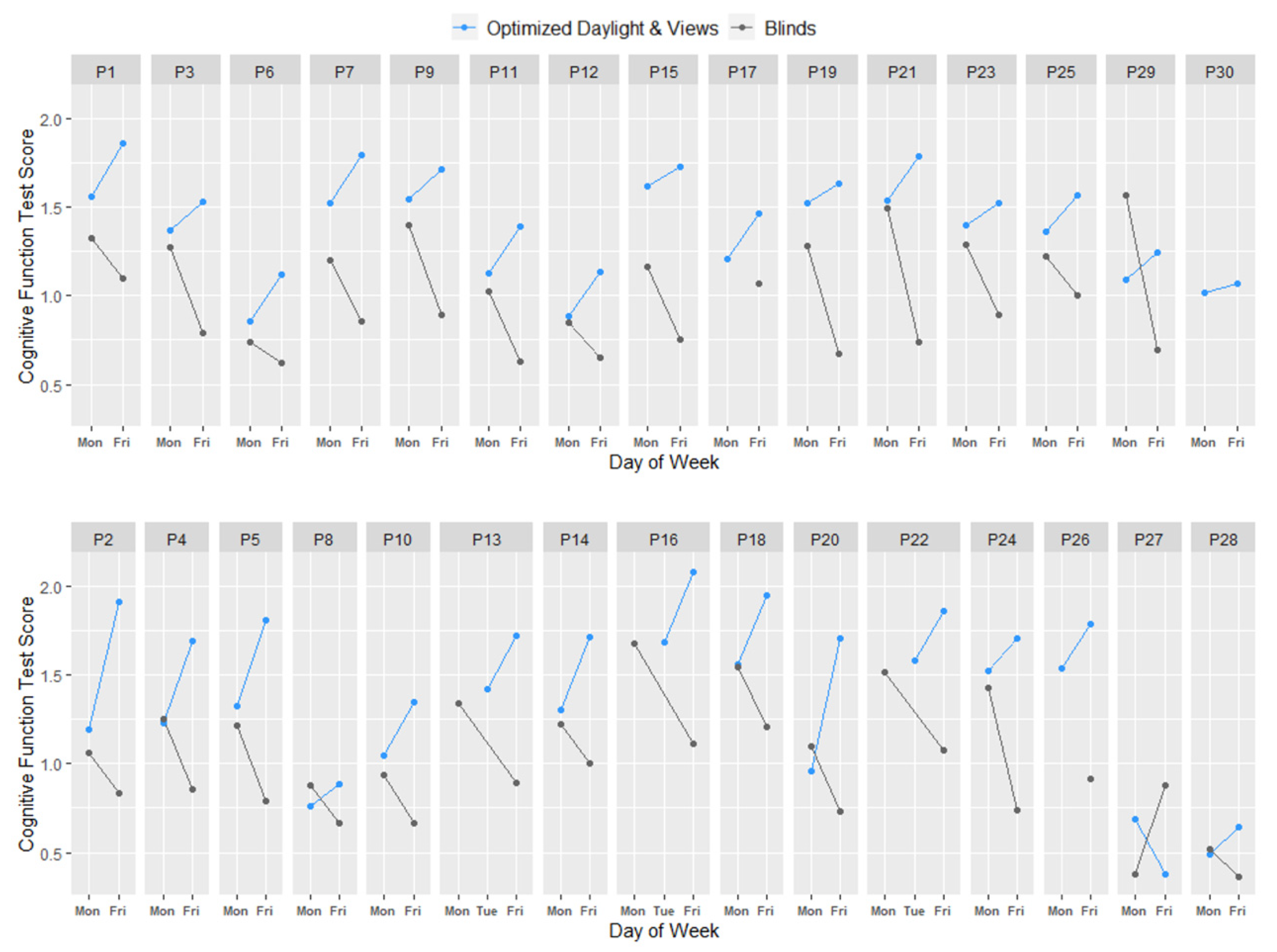
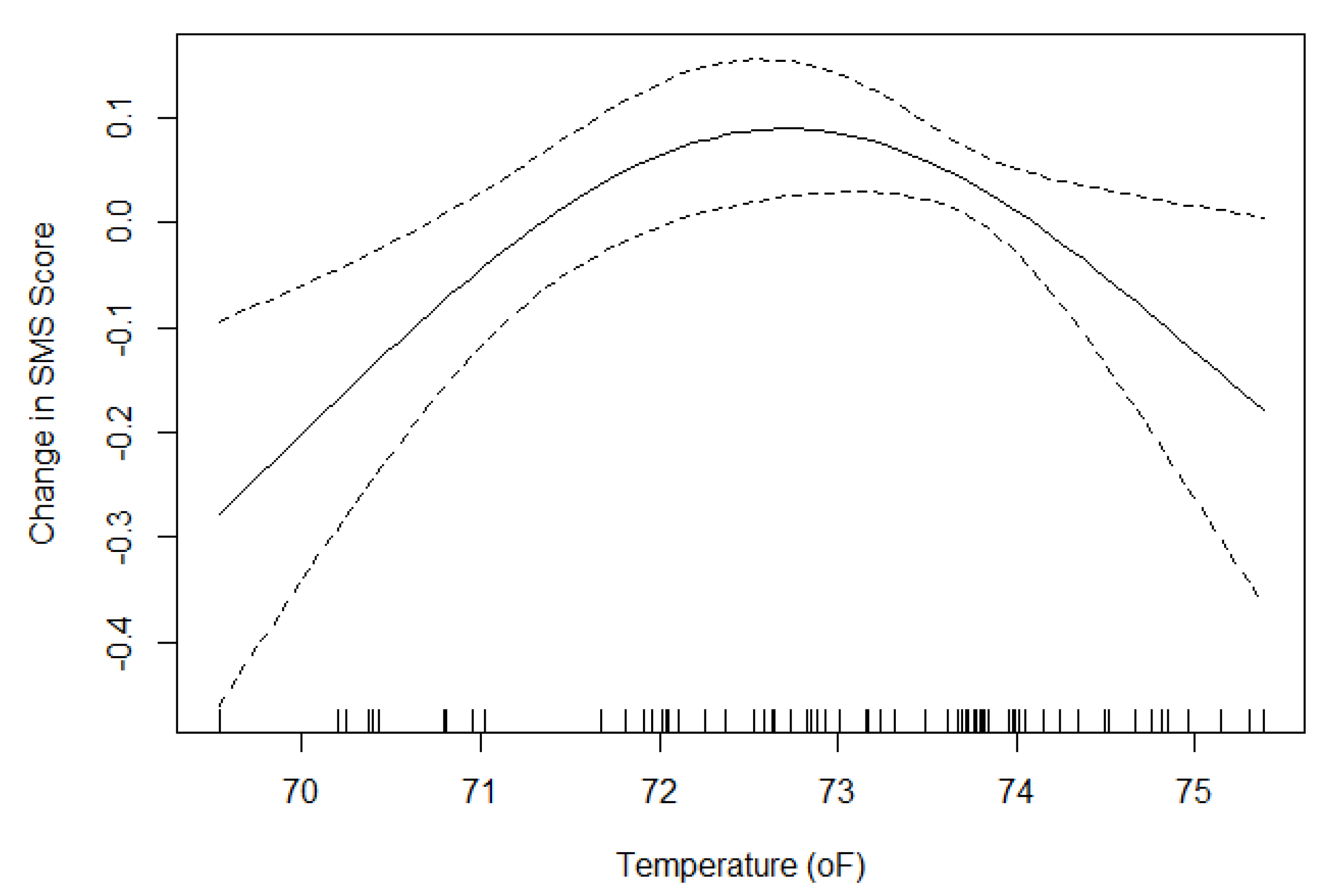
| Total or Average | Group A: Blinds First | Group B: Optimized Daylight & Views First | ||
|---|---|---|---|---|
| Sex | Male | 19 | 9 | 10 |
| Female | 11 | 6 | 5 | |
| Age | Age (years) | 34 | 36.5 | 31.5 |
| Race | White/Caucasian | 16 | 8 | 8 |
| Black/African American | 7 | 4 | 3 | |
| Hispanic/Latino in Origin | 1 | 0 | 1 | |
| Asian | 2 | 1 | 1 | |
| Multiracial | 4 | 2 | 2 | |
| Education | High school graduate | 1 | 0 | 1 |
| Some college | 2 | 1 | 1 | |
| College degree or higher | 27 | 14 | 13 | |
| Job category | Managerial | 4 | 2 | 2 |
| Professional | 15 | 10 | 5 | |
| Technical | 8 | 2 | 6 | |
| Secretarial or Clerical | 1 | 0 | 1 | |
| Other | 2 | 1 | 1 | |
| Lifestyle factors | Childcare duties | 8 | 4 | 4 |
| Major housekeeping | 16 | 8 | 8 | |
| Care for elderly or disabled | 1 | 1 | 0 | |
| Other (education, etc.) | 11 | 7 | 4 | |
| Medications | Allergy | 6 | 3 | 3 |
| Anxiety | 4 | 2 | 2 | |
| Melatonin | 3 | 2 | 1 | |
| Pain | 3 | 1 | 2 | |
| Sleep | 2 | 1 | 1 | |
| Baseline office condition | Daylight rating at work [1,2,3,4,5,6,7,8,9,10] | 7.53 | 7.80 | 7.26 |
| Job satisfaction [1,2,3,4,5] | 4.13 | 4.13 | 4.13 | |
| Baseline Sleep (PSQI) | Global Score | 6.53 | 5.46 | 7.60 |
| Blinds | Optimized Daylight & Views | |
|---|---|---|
| Lighting Conditions | ||
| Horizontal Illuminance (Lux) | 234 | 223 |
| Horizontal EML (Lux) | 185 | 246 |
| Vertical Illuminance—North (Lux) | 18.3 | 143 |
| Vertical EML—North (Lux) | 14.5 | 158 |
| Vertical Illuminance—South (Lux) | 26.2 | 137 |
| Vertical EML—South (Lux) | 20.7 | 151 |
| Vertical Illuminance—West (Lux) | 51.4 | 286 |
| Vertical EML—West (Lux) | 40.6 | 316 |
| CCT (K) | 4122 | 7485 |
| Circadian Stimulus (CS) | 0.05 | 0.42 |
| Indoor Environmental Quality | ||
| Temperature (°F) | 72.3 | 74.1 |
| Relative Humidity (%) | 41.4 | 38.7 |
| CO2 (ppm) | 998 | 893 |
| PM2.5 (µg/m3) | 0.76 | 1.2 |
| TVOC (µg/m3) | 139 | 122 |
| Noise (dB) | 59.8 | 58.0 |
| Variable | Estimate (Minutes) | p-Value |
|---|---|---|
| Baseline Sleep Duration (β0) | 362.21 | <0.001 |
| Condition: Optimized Daylight & Views (β1) | 36.96 | <0.001 |
| Melatonin, Yes/No (β2) | 27.09 | 0.396 |
| Evening exercise, Yes/No (β3) | 22.51 | 0.137 |
| Alcoholic drinks (β4) | −2.48 | 0.796 |
| Caffeine after 12 pm, Yes/No (β5) | −16.23 | 0.316 |
| Evening screen time, hours (β6) | −6.85 | 0.313 |
| Good Sleepers | Poor Sleepers | |||
|---|---|---|---|---|
| Variable | Estimate (Minutes) | p-Value | Estimate (Minutes) | p-Value |
| Baseline Sleep Duration (β0) | 390.46 | <0.001 | 344.55 | <0.001 |
| Condition: Optimized Daylight and Views (β1) | 18.08 | 0.214 | 52.80 | <0.001 |
| Melatonin, Yes/No (β2) | 18.30 | 0.599 | ||
| Evening exercise, Yes/No (β3) | −3.87 | 0.813 | 25.86 | 0.297 |
| Alcoholic drinks (β4) | 19.57 | 0.062 | −22.95 | 0.132 |
| Caffeine after 12 pm, Yes/No (β5) | −39.59 | 0.020 | −10.52 | 0.648 |
| Evening screen time, hours (β6) | −4.71 | 0.651 | −6.19 | 0.487 |
| Variable | Estimate | p-Value |
|---|---|---|
| Intercept (β0) | 0.99 | <0.0001 |
| Condition: Optimized Daylight & Views (β1) | 0.42 | <0.0001 |
| s(Temp) | - | 0.006 |
© 2020 by the authors. Licensee MDPI, Basel, Switzerland. This article is an open access article distributed under the terms and conditions of the Creative Commons Attribution (CC BY) license (http://creativecommons.org/licenses/by/4.0/).
Share and Cite
Boubekri, M.; Lee, J.; MacNaughton, P.; Woo, M.; Schuyler, L.; Tinianov, B.; Satish, U. The Impact of Optimized Daylight and Views on the Sleep Duration and Cognitive Performance of Office Workers. Int. J. Environ. Res. Public Health 2020, 17, 3219. https://doi.org/10.3390/ijerph17093219
Boubekri M, Lee J, MacNaughton P, Woo M, Schuyler L, Tinianov B, Satish U. The Impact of Optimized Daylight and Views on the Sleep Duration and Cognitive Performance of Office Workers. International Journal of Environmental Research and Public Health. 2020; 17(9):3219. https://doi.org/10.3390/ijerph17093219
Chicago/Turabian StyleBoubekri, Mohamed, Jaewook Lee, Piers MacNaughton, May Woo, Lauren Schuyler, Brandon Tinianov, and Usha Satish. 2020. "The Impact of Optimized Daylight and Views on the Sleep Duration and Cognitive Performance of Office Workers" International Journal of Environmental Research and Public Health 17, no. 9: 3219. https://doi.org/10.3390/ijerph17093219
APA StyleBoubekri, M., Lee, J., MacNaughton, P., Woo, M., Schuyler, L., Tinianov, B., & Satish, U. (2020). The Impact of Optimized Daylight and Views on the Sleep Duration and Cognitive Performance of Office Workers. International Journal of Environmental Research and Public Health, 17(9), 3219. https://doi.org/10.3390/ijerph17093219







